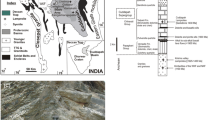Summary
Mesozoic melilite-bearing ultramafic lamprophyres are developed as sill, dyke and plug-like intrusive bodies in the East Antarctic Beaver Lake area. They consist of varying amounts of olivine, melilite, phlogopite, nepheline, titanomagnetite and perovskite as major phases, accompanied by minor amounts of apatite, carbonate, spinel, glass and, rarely, monticellite. The rocks are mineralogically and geochemically broadly similar to olivine melilitites, differing in higher CO2 and modal phlogopite and carbonate contents. The ultramafic lamprophyres are MgO-rich (13.4–20.5 wt%) and SiO2-poor (32.8–37.2 wt%), indicative of a near-primary nature. Major and trace element features are consistent with minor fractionation of olivine and Cr-spinel from melts originating at depths of 130–140 km.
Primary melts originated by melting of upper mantle peridotite which had been veined by phlogopite + carbonate + clinopyroxene-bearing assemblages less than 200 Ma before eruption. The presence of the veins and their time of formation is required to explain high incompatible trace element contents and growth of 87Sr/86Sr, leaving 143Nd/144Nd unaffected. The major element, compatible trace element, and most radiogenic isotope characteristics are derived from melting of the wall-rock peridotite. The depth of about 130 km is indicated by the presence of phlogopite rather than amphibole in the veins, by control of the REE pattern by residual garnet, by the high MgO content of the rocks, and by the expected intersection of the rift-flank geotherm with the solidus at this depth. The higher CO2 contents than are characteristic for olivine melilitites favoured the crystallization of melilite at crustal pressures, and suppressed the crystallization of clinopyroxene. The Beaver Lake ultramafic lamprophyres are a distal effect of the breakup of Gondwanaland, too distal to show a geochemical signature of the Kerguelen plume. Upward and outward movement of the asthenosphere-lithosphere boundary beneath the Lambert-Amery rift led first to the production of phlogopite- and carbonate-rich veins, and later to the generation of the ultramafic lamprophyres themselves.
Similar content being viewed by others
Author information
Authors and Affiliations
Additional information
Received March 31, 2000; revised version accepted September 3, 2001
Rights and permissions
About this article
Cite this article
Foley, S., Andronikov, A. & Melzer, S. Petrology of ultramafic lamprophyres from the Beaver Lake area of Eastern Antarctica and their relation to the breakup of Gondwanaland. Mineralogy and Petrology 74, 361–384 (2002). https://doi.org/10.1007/s007100200011
Issue Date:
DOI: https://doi.org/10.1007/s007100200011




